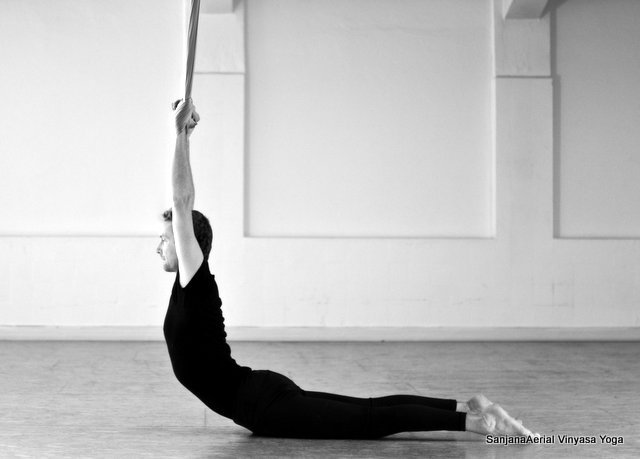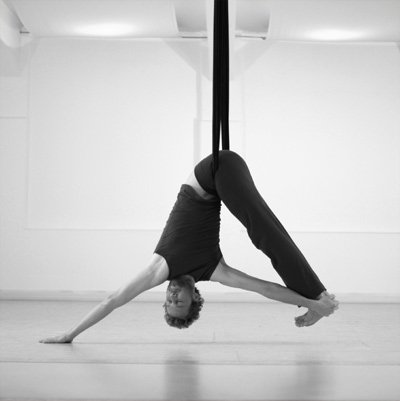 The ideal beginner for any aerial yoga style
The ideal beginner for any aerial yoga style
- has a decent background and practice of floor yoga and
- wants to progress into deeper and new experiences
- with plenty of fun on the way
- & enjoys an occasional workout
However it is absolutely possible to start Sanjana Yoga without any prior experience of Yoga.
It is still a good idea to attend floor classes regularly with your Aerial practice for two reasons :
- It helps to deepen your understanding of basic yoga postures when also practicing without the hammock. Which makes it easier to focus for beginners. This will speed up your learning curve.
- The floor favours forward bending, whereas the hammock leads typically easier towards backbends.
To balance these two directions, we use the floor as well in a regular Sanjana Aerial Yoga Class, but a regular floor practice is still more forward-bendy. You may see floor Yoga and Aerial Yoga as two halves that enhance each other. Each by itself is great, but the two together are more than their sum.
Sun Salutations are sequences of moves and poses which are repeated a few times somewhere in the beginning of a class.
SS include patterns that are fundamental and clarify our alignment in space.
They always move and balance the body and bring us back to center. This is why they pretty much always include Standing, a forward bend, AdhoMukha Svanasana & some type of backbend.
AdhoMukha Svanasana and Standing (in Tadasana) supply much of the centering part, whereas the forward and back bends bring in the movement and still remain in balance within their opposition.
They are in principle rather simple, easy to learn and repeat, but not necessarily easy to perfect. On the contrary. The sequence is easy to learn and remember, but the details and elements they contain have to be worked on for a lifetime.
The SS have a habit of making us aware of where we still need to put in some effort, where we still are out of balance.
Sun salutations also are the first sequences that identify the entanglement between breath and movement, which then can manifest itself throughout the whole practice. The conscious choice and clarity of connecting breath with movement creates a focus, which defines a yogapractice of awareness and integration.
So far, we have 3 Aerial Yoga Sun Salutations which satisfy the above conditions. They come in initial (beginner) and more experienced variations.
They lead into different cycles & sequences of asana and are also used for transitions.
One you learned them in a Workshop or training you can refresh your memory and watch the Aerial Sun Salutation Videos :
- TicToc with Jule (Aerial Vinyasa Teacher Innsbruck)
- All three with Lucas.
So. You think that Aerial Yoga is easy because the weight is held by the hammock.
Think again ...
 Aerial Yoga has often been advertised as a much less strenuous form of yoga.
Aerial Yoga has often been advertised as a much less strenuous form of yoga.
The pictures in ads look always serene and easy to achieve. Sure it is easy to let the hammock carry your weight and let your body hang upside down.
Still, your whole body, even in the simplest and easiest of these inversions, is getting an internal workout.. And in movement, your whole body works in a concert of mobility, balance and stability, especially when it looks effortless.
With the hammock holding you, you can release into your weight, but this is done very specifically in some muscles & structures, while at the same time having to stabilize and strengthen others. The contrast between simultaneously releasing and engaging is enhanced especially when we are suspended.
Some poses allow for more release, and others need an almost a fully engaged body, but both elements are always present, and both elements work us in their own way.
